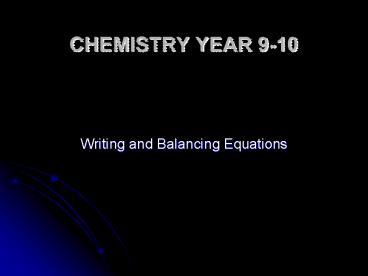CHEMISTRY YEAR 910 - PowerPoint PPT Presentation
1 / 16
Title: CHEMISTRY YEAR 910
1
CHEMISTRY YEAR 9-10
- Writing and Balancing Equations
2
Writing and Balancing Equations
- A chemical equation is a shorthand expression for
a chemical change or reaction. - word - equation states in words
- mercury (II) oxide heat mercury oxygen
- bulky and cumbersome
- 2 HgO 2Hg O2
3
Writing and Balancing Equations
- General Format for Writing Equations
- 1. The reactants are separated from the products
by an arrow that indicates the direction of
the reaction. - 2. The reactants are placed to the left and the
products to the right of the arrow. A plus sign
() is placed between reactants and between
products when needed.
4
Writing and Balancing Equations
- 3. Conditions required to carry out the
reaction may be placed above or below the arrow.
A delta indicates heat is applied. - 4. Coefficients 2 H2O are placed in front to
balance the equation. One is never placed there,
it is just understood.
5
Writing and Balancing Equations
- 5. The physical state of a substance is indicated
by the following symbols - (s) solid (l) liquid (g) gaseous (aq)
aqueous means water solution - yields reversible
- reaction
- H2 gas evolved solid precipitate
6
Writing and Balancing Equations
- Balancing Equations
- 1. First you must have the equation in symbol
format, you cannot balance a word equation. - 2. Balancing
- a. Count and compare the number of atoms of
each element on each side of the equation and
determine those that must be balanced.
7
Writing and Balancing Equations
- Balancing Equations
- b. Balance each element one at a time, by
placing whole numbers (coefficients) in front of
the formulas containing the unbalanced element. - It is usually better to balance in this order
metals, nonmetals, hydrogen, oxygen.
8
Writing and Balancing Equations
- A coefficient placed before a formula multiplies
every atom in the formula by that number! - 2H2SO4 4Hs 2Ss 8Os
- c. re-check each time you balance an element
to see if anything else has become unbalanced.
Make adjustments as needed.
9
Writing and Balancing Equations
- d. Do a final check making sure that each
element is balanced and that the smallest
possible set of whole number coefficients has
been used - 4HgO 4Hg 2O2 incorrect
- 2HgO 2Hg O2 correct
10
Writing and Balancing Equations
- Equations for practice
- Magnesium oxygen Magnesium Oxide
- Potassium Chlorate Potassium Choride
Oxygen - Aluminum hydroxide sulfuric acid
- Aluminum sulfate water
- C4H10 O2 CO2 H2O
11
Writing and Balancing Equations
- Types of Chemical Reactions
- 1. Combination or Synthesis Reaction
- Two reactants combine to give one product.
- A B AB
- 2Mg O2 2MgO
12
Writing and Balancing Equations
- Types of Chemical Reactions
- 2. Decomposition
- A single substance is decomposed or broken
down to give two or more different substances - AB A B
- 2PbO2 2PbO O2
- 2 Na HCO3 Na2CO3 H2O CO2
13
Writing and Balancing Equations
- Types of Chemical Reactions
- 3. Single - Displacement Reaction
- One element reacts with a compound to take the
place of one of the elements of that compound. - A BC B AC
- Zn 2HCl H2 ZnCl2
- Note Activity series table helps to predict
which substances (elements) will be able to
replace various other substances.
14
Writing and Balancing Equations
- Types of Chemical Reactions
- 4. Double - Displacement or Metathesis
- Two compounds exchange partners with each
other to produce two different compounds. - AB CD AD CB
- NaCl KNO3 NaNo3 KCl
15
Writing and Balancing Equations
- Heat in Chemical Reactions
- Energy changes always accompany chemical
reactions. One reason why reactions occur is
that the products attain a lower, more stable
energy state than the reactants.
16
Writing and Balancing Equations
- Heat in Chemical Reactions
- Reactions are either exothermic or endothermic.
- Exothermic reactions liberate heat
- H2 Cl2 2HCl 185kJ (exothermic)
- Endothermic reactions absorb heat
- N2 O2 181kJ 2NO (endothermic)































